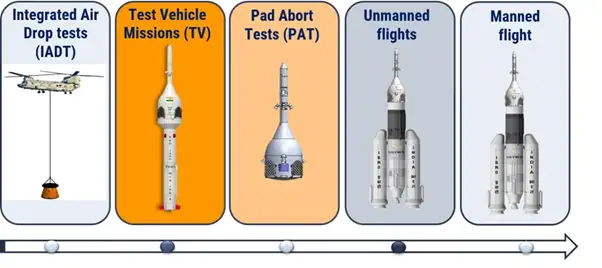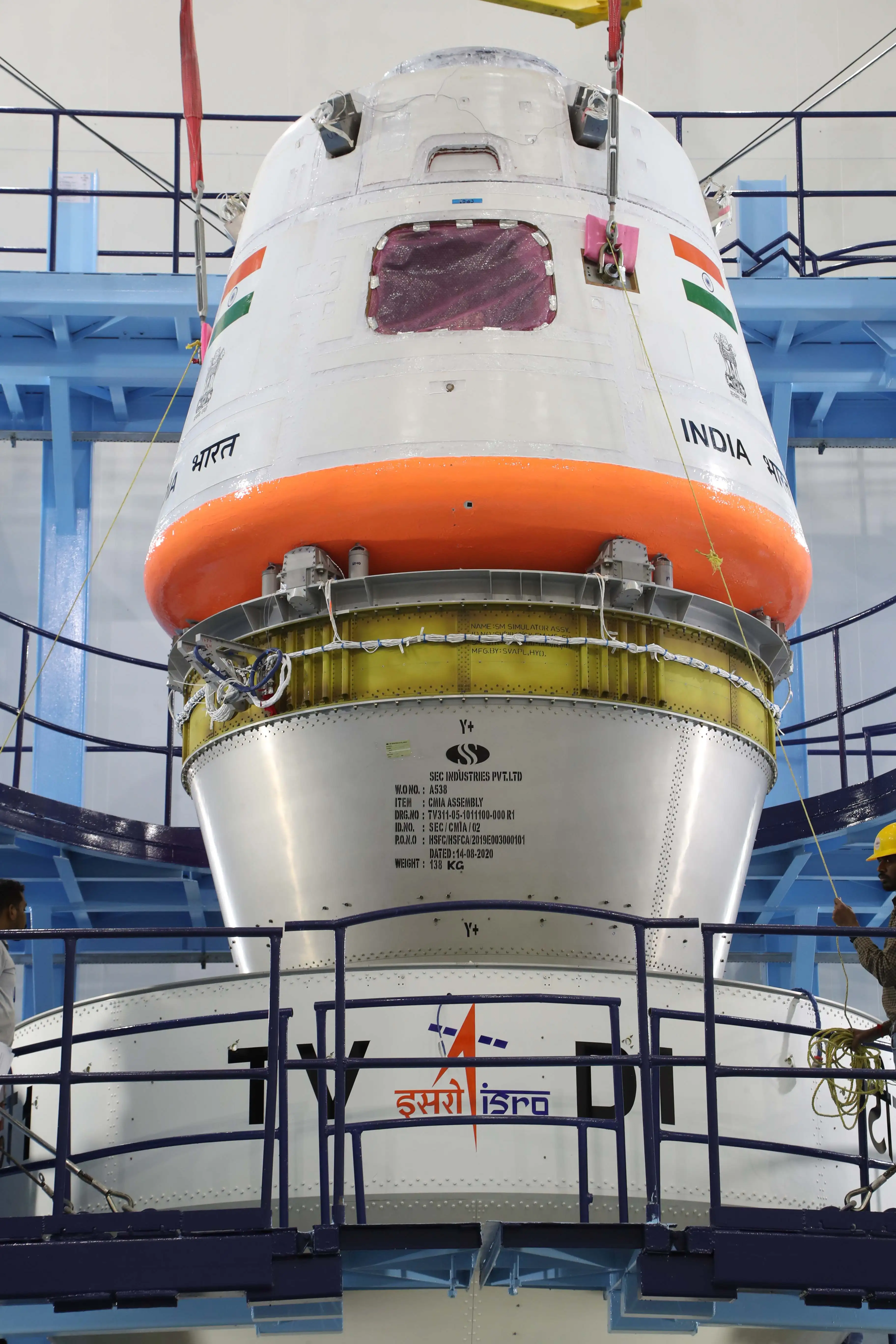Table of Contents
2 Gaganyatris who are part of Axiom-4 Mission have completed their initial training phase.
Gaganyaan Mission
Objectives of the Gaganyaan Mission
- To send a crew of 3 astronauts into orbit around Earth for 3 days and then safely return them to Earth.
- To demonstrate India’s ability to conduct human spaceflight missions to Low Earth Orbit (LEO).
The program involves 3 Flights
- First uncrewed flight: It will test the safety mechanisms and demonstrate the performance of the Crew Escape System of the Gaganyaan Mission.
- Second uncrewed flight: This flight will carry Vyom Mitra, a humanoid robot that can speak with ground controllers and read instrument panels.
- First crewed flight: It will carry a crew of 3 astronauts who will spend 3 days in LEO. A mission will conclude with a controlled landing in the Indian Ocean.

Launch Vehicle: LVM 3
- It is a three-stage rocket with a solid stage, liquid stage, and cryogenic stage.
- It also includes a Crew Escape System (CES) and an Orbital Module.

4 Astronauts Selected for ISRO’s Gaganyaan Mission
Four astronauts have been selected by the Indian Space Research Organisation (ISRO) for the prestigious Gaganyaan mission. Prime Minister Narendra Modi introduced them to the world. The four astronauts selected for the mission are:
- Group Captain Prashanth Nair
- Group Captain Angad Pratap
- Group Captain Ajit Krishnan
- Wing Commander Shubhanshu Shukla
All four are Indian Air Force (IAF) test pilots from the Aircraft and Systems Testing Establishment (ASTE) in Bengaluru. The mission was first announced by Prime Minister Narendra Modi in 2018 in his Independence Day address to the nation.

Rigorous Training and Preparation
Selected four years ago, these astronauts have undergone rigorous training for the past four years. They were chosen from a pool of test pilots, with a selection process that included multiple rounds conducted by the Institute of Aerospace Medicine (IAM) and ISRO. Initial training took place in Russia, followed by continuous modules and simulations in India. The astronauts have also maintained their fitness through regular flying with the IAF.
| About Axiom 4 Mission |
|
ISRO Achieves Human Rating for CE20 Cryogenic Engine
India’s Gaganyaan mission receives a boost as ISRO accomplishes human rating for its CE20 cryogenic engine. Seven ground qualification tests, including 39 hot firing tests, were conducted at ISRO Propulsion Complex, Mahendragiri, exceeding the required 6350 seconds.
Tests assessed engine performance under various conditions, ensuring safety for manned missions. The CE20 engine demonstrates reliability, enduring life demonstration, endurance, and performance evaluations. ISRO’s milestone marks progress toward launching humans into space under the Gaganyaan program, showcasing India’s growing capabilities in space exploration.

| Fact |
| After successful launch, India will become the 4th nation in the world to launch a Human Spaceflight Mission after USA, Russia, and China. |
Mission Gaganyaan TV-D1 Launch Date
The inaugural test flight for the Gaganyaan mission occurred on October 21, 2023, at the Sriharikota spaceport at 10 am in 2nd Attempt. This milestone flight will showcase the capabilities of the crew escape system.
Gaganyaan TV-D1 Mission Definition
Test of the Crew Escape System (CES) at Mach 1.2 using the newly developed Test Vehicle, followed by separation of the Crew Module and its safe recovery.
Gaganyaan TV-D1 Mission Objectives
- Flight demonstration and evaluation of Test Vehicle sub-systems.
- Flight demonstration and evaluation of Crew Escape System including various separation systems.
- Crew Module characteristics & deceleration systems demonstration at higher altitude & its recovery.

We’re now on WhatsApp. Click to Join
Gaganyaan TV-D1 Mission Highlights
| Gaganyaan TV-D1 Mission Highlights | |
| TV Mission Pillbox |
|
| CM-CES separation |
|
| Drogue Parachute deployment |
|
| Main Parachute |
|
TV-D1 Vehicle
The Test Vehicle is a single-stage liquid-propelled rocket that uses a modified VIKAS engine. The Crew Module (CM) and Crew Escape System (CES) are mounted at its front end.
What is Gaganyaan Mission?
The Gaganyaan project is India’s ambitious quest for human spaceflight. It aims to launch a crew of three members into a 400-kilometre orbit for a three-day mission before safely returning to Earth in the Indian sea waters. This collaborative endeavour combines India’s expertise, industry experience, academic knowledge, and international technology.
Critical components include a human-rated launch vehicle, life support systems, crew emergency escape provisions, and meticulous crew management for training, recovery, and rehabilitation. Preliminary missions, including Integrated Air Drop Tests, Pad Abort Tests, and Test Vehicle flights, ensure technology readiness and system reliability before the actual manned mission. Gaganyaan marks a significant step in India’s space exploration journey.
Key Components of Gaganyaan Mission
| Component/Technology | Description |
| Human-Related Launch Vehicle | Essential for launching astronauts into space. |
| Habitable Orbital Module | Includes the Crew Module and Service Module, weighing approximately 8000 kilograms. |
| Life Support System | Ensures astronaut life support during the mission. |
| Crew Escape System | Provides emergency evacuation capability. |
| Crew Selection and Training | Activities related to astronaut selection, training, and mission management. |
| Unmanned Prototype Missions | Prior to the manned mission, two unmanned missions for technology testing and safety verification. |
| Robot Vyommitra | An advanced robot to simulate human space activities and challenges. |
| Collaborators in Gaganyaan Mission | Various Indian agencies, including the Armed Forces, DRDO, maritime agencies, and academic institutions. |
Gaganyaan-1
Gaganyaan-1 marks the inaugural uncrewed test flight within the Gaganyaan program, scheduled for the first quarter of 2024. This groundbreaking program represents India’s maiden indigenous mission to transport Indian astronauts into space. The primary objective is to construct a human-friendly space capsule designed to accommodate a crew of three individuals, launching them into a 400 km (250 miles) orbit for a three-day mission filled with various scientific experiments.
The mission will culminate with a carefully planned splashdown in the Indian Ocean. The Gaganyaan spacecraft will be positioned in a low earth orbit (LEO) ranging from 300 to 400 kilometres, propelled into space via an LVM 3 rocket, enabling astronauts to reach space in just 16 minutes.
Gaganyaan Test Mission
The Gaganyaan test mission will involve sending the crew module to a height of 17 kilometers above the Earth’s surface. This is a remarkable milestone, as helicopters and conventional flights can only reach altitudes of about 10 kilometers. The single-stage liquid propellant-based rocket will carry an unpressurized version of the crew module, simulating the size and mass of the module intended for Indian astronauts.
Strategic Second Test Vehicle Mission
Following the success of the first test mission, ISRO will consider scheduling a second one. This decision hinges on the data generated and insights gained from the initial test. If everything proceeds as planned, the second mission will be on the horizon. However, in the event of unforeseen challenges, ISRO will address and rectify any issues before embarking on the subsequent phase.
Importance of Gaganyaan Test Mission
The Gaganyaan project is a watershed moment for India’s space exploration endeavours. The altitude of 17 kilometers, which this test will achieve, is a significant milestone. It surpasses the capabilities of helicopters or flights, which can reach a maximum of about 10 kilometers. This demonstrates India’s commitment to pushing the boundaries of space exploration.
The program’s trajectory includes an unmanned flight, where a similar unpressurized crew module will venture into space. This step follows the successful completion of two test missions, ensuring all systems are primed for action. The final manned mission will involve a pressurized crew module to simulate Earth’s atmospheric conditions, emphasizing the utmost concern for astronaut safety. Only after two successful unmanned flights will Indian astronauts embark on their journey under the Gaganyaan mission.
Future of Gaganyaan Mission
With the crew module for the next test mission already in fabrication and testing, the excitement around Gaganyaan continues to grow. This upcoming mission will simulate a scenario in which astronauts must abort while ascending to space at speeds exceeding 1.2 times the speed of sound, further testing the resilience and adaptability of the system.
Mission Gaganyaan UPSC
In a historic event, ISRO is preparing for the maiden test vehicle mission of its ambitious Gaganyaan project. This mission, scheduled for October 21, 2023, aims to test the mid-flight crew escape system, a pivotal step towards India’s dream of human spaceflight. Gaganyaan aspires to send a crew of three on a three-day mission into a 400-kilometre orbit before their safe return to the Indian sea waters.
The mission involves vital components like a human-rated launch vehicle, life support systems, and crew management. Uncrewed prototype missions precede the manned mission, with a robot named Vyommitra mimicking astronaut activities. This venture marks a significant leap in India’s space exploration journey.


 Amazon’s Project Kuiper Gains Momentum...
Amazon’s Project Kuiper Gains Momentum...
 National Supercomputing Mission (NSM)
National Supercomputing Mission (NSM)
 SIPRI Report on Global Arms Spending and...
SIPRI Report on Global Arms Spending and...





















